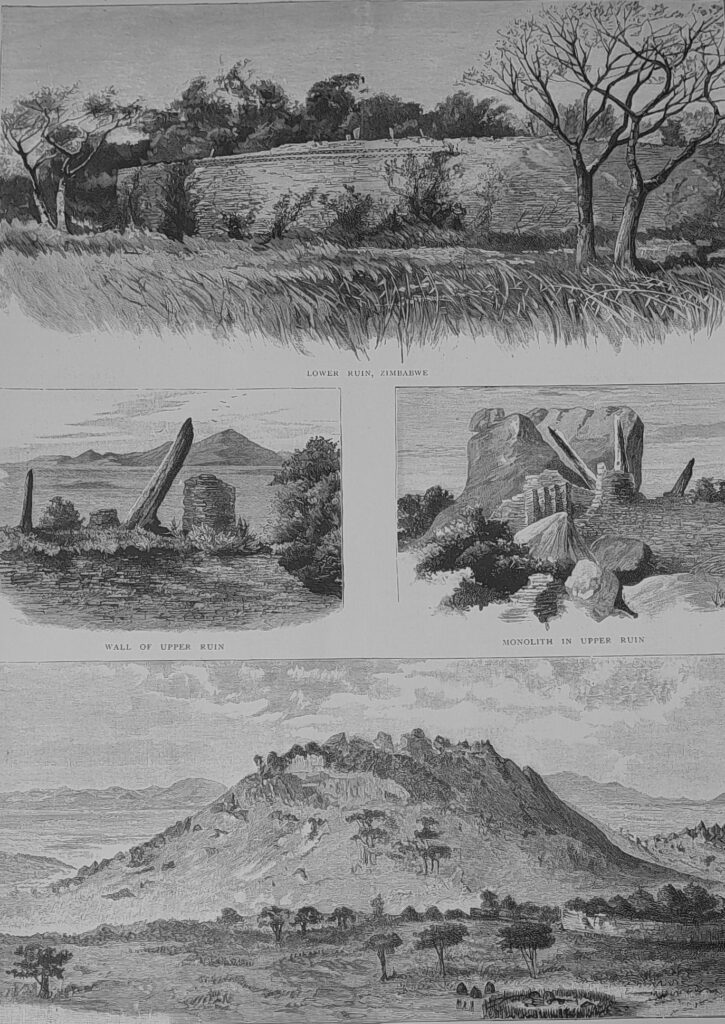Pre-Mahomedan Relics – Excavations at the Great Zimbabwe
Theodore Bent’s article for Black & White, April 2, 1892, pp. 430-1. The original article contains several lithographs of the site and finds, prepared from Mabel Bent’s original photographs and a series of watercolours by Bent (now inaccessible in the National Archive, Harare). All the images also appear in Bent’s “The Ruined Cities of Mashonaland” (1892).
‘Pre-Mahomedan Relics’, is, of course, controversial and now generally disproved. Bent himself was unsure at first as to what date to put on the monuments but by 1892, for various reasons and pressures, published in various articles such as this present one, that they were very early, perhaps even dating from his perception of ‘Phoenician’ times and were not built by local populations. His interpretation led to 100 years of controversy over the ruins of Great Zimbabwe – it also made Theodore and Mabel Bent the celebrity explorers of the decade.

Mr. Theodore Bent, the well-known archaeologist, has just returned from an expedition to Mashonaland for the purpose of exploring and excavating the Zimbabwe ruins. He was accompanied by his wife, who has always been his intrepid companion on these occasions, and spent two months at the work. The whole country west of the Sabe River is scattered with ruins of a period Mr. Bent considers to be pre-Mahomedan, and of these the Zimbabwe are the chief. The following notes on his important excavations have been specially written for us by Mr. Bent, and are illustrated by photographs taken by Mrs. Bent:-
“After two months hard work in excavating the ruins of Zimbabwe, our exertions brought to light a goodly amount of spoil belonging to that mysterious race which peopled the country from the Zambesi to the Limpopo in former ages. Sufficient has now been added to our knowledge of this race to definitely decide on its origin, its worship, its commerce, and mode of life. The lower ruin at Zimbabwe, with its massive circular tower and curious labyrinthine walls, yielded very little on excavation, for it had been inhabited until quite recently by Kaffirs, who had obliterated almost every trace of the former inhabitants; fortunately, however, on the hill the case was different. The ancient town faced south-east, where it gets little sun, and the ruins were almost hidden in jungle, consequently the present Kaffir inhabitants have built their kraal on the other side of the mountain, and troubled themselves little about disturbing records of the past.
“Our chief finds were made in a building used as a cattle-stable by the ‘Induna’ of Zimbabwe; this was the ancient temple of the upper town. Here we found a considerable number of beams of soapstone, carved into birds at their upper extremity; these were ranged along the outer wall, and near them we found several iron bells, which are, curiously enough, still in use amongst the tribes on the Congo. An altar occupied the centre of the building, near which are found a large number of objects used in heathen worship. Adjoining the temple was a curious depression, carefully walled in, which was united to the temple by two doors, and itself communicated with several caves. This point proved the most interesting of any that we excavated, for here the ancient inhabitants had their gold smelting furnace, and we added to our collection of objects a large number of smelting crucibles and tools, all with traces still on them of the precious metal which had been worked. Here, too, we found fragments of a great many soapstone bowls, one being almost perfect, and representing round it an interesting scene of hunting after native animals. One fragment had an inscription round it, valuable as the only one we discovered at Zimbabwe. In the cave we found fragments of very fine pottery, and also traces of mediaeval intercourse with far-off nations in the presence of fragments of Persian and Celadon china. Gilt spear-heads and other weapons pretty nearly sum up the total of the finds in this fertile corner of the ancient ruins.
“The view from the summit of these ruins, from the massive wall 13 feet thick, decorated with round towers, and ornamented beams of soapstone, is remarkably fine, showing the advantage of the situation for defence, being situated as it is in an undulating plain, hemmed in by high mountains, and watered by several rivers; but it took us long to clear away the thick undergrowth which impeded our work, and it was not until the close of our stay at Zimbabwe that we could contemplate this view with satisfaction.
“The clearing out of the ancient approach to this citadel was a work of considerable labour, every thing had been for protection, the path led along the edge of a precipice seventy feet high, and yet this was not considered sufficient, for they had built on it a double wall 30 feet in height; then the path with small steps led through a natural split in the granite, scarcely wide enough for a man to pass through broadways, and by a series of curves protected with ambuscades, traverses, etc., this remarkable path led down between two high walls to the plain.
“After leaving Zimbabwe we visited other sets of ruins near the Sabae also of great interest, being a complete line of forts built in the same style as those at Zimbabwe. In the Mazoe goldfields we also found another similar one, erected by the ancient gold-workers to protect the miners.” J. Theodore Bent.
